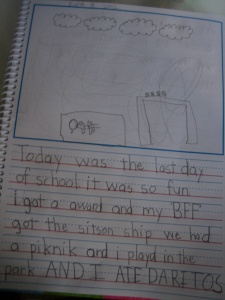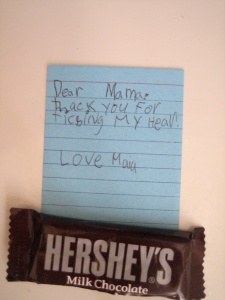When should I correct the spelling?
As a former first grade teacher, I am constantly asked when children’s spelling should be corrected.
My very simple answer is: if it is a word that your child SHOULD know how to spell correctly, then it should be corrected, otherwise don’t.
If a 4-year child spelled ball, /BL/. I wouldn’t correct it.
If a first grader spelled ball the same way, I would.
If a kindergartner spelled blue, /BLU/. I would leave it.
If a first grader spelled blue the same way, I would get a blue crayon and show him the label, and then have him correct it.
If a first grader spelled mountain, /MOUNTEN/. I would leave it.
If a third grader spelled it that way, I would point it out and have the child think where he could find the correct spelling for it, or think of another way to spell it.
In my opinion, the important consideration is the manner by which the spelling is corrected. Pointing out spelling errors as the child is writing could be frustrating. But, letting the child complete the work while giving him praises for his effort, and then going back to the misspelled words could spell the difference (pun intended).
Example:
The 6-year old child writes in the grocery list: meetballs
Parent: I see you spelled meat, M-E-E-T. You are right, meet is spelled that way. But that meet means when a group of people gather together to discuss something, like in a meeting.
What other ways can you make the long E sound, like in the word /meat/?
At this point the child can say, add /e/ at the end of the word, like Pete; or /ea/ like in the word read.
Then, you can write the two ways and ask him which one looks right, or you can simply say that the second one is the correct spelling.
Four, Five, Six, and Seven-year olds are just learning that they can actually put their thoughts into writing. They can write notes, make lists, and create stories that relay information and contain ideas. These creative pieces are extensions of themselves.
Interest to write should be encouraged first, and then spelling, grammar and syntax follow next.
As a teacher (as a mom, too) I would rather be handed a piece of writing riddled with misspelled words, than not to have any piece of writing at all because my child is worried that words may not be spelled correctly.
 At 5, an advertisement my daughter wrote to teach reading
At 5, an advertisement my daughter wrote to teach reading
 At the end of Kindergarten (almost 6)
At the end of Kindergarten (almost 6)
+++++++++++++++++++++++++++++++++++++++++++++++++++++++++++++++++++++
Spelling is one of the strong suits of children educated in the Philippines. I think it is because Filipinos read words exactly as they are spelled, without the American twang. Spelling is also considered as an important part of the Language Arts block.
WAS is read with a short vowel sound /a/, instead of a short vowel sound /u/.
TRAIN is read as T-R-ain, instead of the American English accent, chrain.
Tagalog spelling is much easier because the spelling rules are simple: All vowels are read as short vowel sounds and each letter in the word is pronounced except for the digraph /ng/.
leeg (neck)—le-eg
paa (foot)—pa-a
kamay (hand)—ka-may (not May as in the month, but /ma/ like Mama + /y/
bato (stone)–ba-to (short vowel /o/ as in Oscar)
English spelling is definitely more confusing than Tagalog.
 My daughter’s writing at 4
My daughter’s writing at 4




